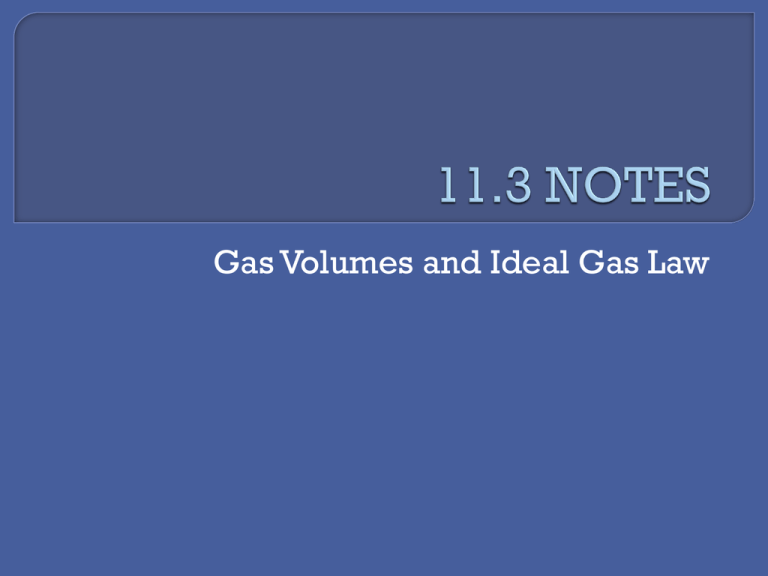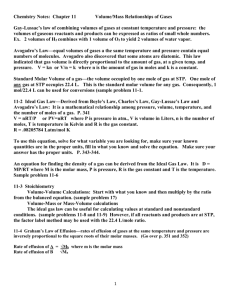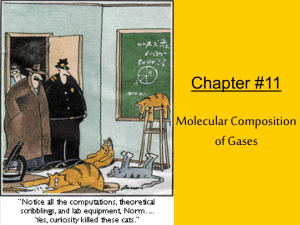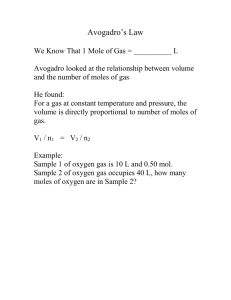11.3 & 4 notes
advertisement

Gas Volumes and Ideal Gas Law Up to this point, the gas laws have kept the amount of gas (moles) the same. Up to this point, the gas laws have kept the amount of gas (moles) the same. Law of combining volumes of gases Up to this point, the gas laws have kept the amount of gas (moles) the same. Law of combining volumes of gases At a constant temp and pressure, the volumes of gases in a chemical equation are in a whole number ratio (same as the coefficients) Up to this point, the gas laws have kept the amount of gas (moles) the same. Law of combining volumes of gases At a constant temp and pressure, the volumes of gases in a chemical equation are in a whole number ratio (same as the coefficients) Ex : 3H2 + 2N2 2NH3 Up to this point, the gas laws have kept the amount of gas (moles) the same. Law of combining volumes of gases At a constant temp and pressure, the volumes of gases in a chemical equation are in a whole number ratio (same as the coefficients) Ex : 3H2 + 2N2 2NH3 3L of H2 + 2L of N2 = 2L of NH3 or 3mL of H2 + 2mL of N2 = 2mL of NH3 Avogadro’s Law Avogadro’s Law At a constant temp and pressure, equal volumes of gases contain the same number of particles. Avogadro’s Law At a constant temp and pressure, equal volumes of gases contain the same number of particles. Ex: 3L of H2 will contain the same number of particles as 3L of O2. (as long as they are at the same temp and pressure) Ex: At STP, 1 mole of an ideal gas = 22.4 L The gases below are all at STP. Why are their volumes all not 22.4 L? Ideal Gas Law Ideal Gas Law This law combines Boyle’s, Charles’s, Gay-Lussac’s, and Avogadro’s. Ideal Gas Law This law combines Boyle’s, Charles’s, Gay-Lussac’s, and Avogadro’s. R is a gas constant. The value depends on the units used in the problem. Example 1: What volume will 1.27 moles of helium occupy at STP? Example 2: Determine the number of moles of krypton contained in a 3.25L gas tank at 5.80 atm and 25.5ºC. Example 3: Determine the number of grams of carbon dioxide in a 450.6mL tank at 1.80 atm and -50.5ºC. Example 4: A 50.0L tank at -15ºC contains 14.00g of helium and 10.00g of nitrogen. What is the pressure in the tank? Example 5: What volume would 32.0g of NO2 gas occupy at 3.12 atm and 18.0 ºC? Example 6: A 40.0g gas sample occupies 11.2 L at STP. What is the molar mass of this gas? Example 7: 1.089g of a gas occupies 4.50L at 20.5 ºC and 0.890 atm. What is its molar mass? The ideal gas law can be used along with stoichiometry to determine the volume or pressure of a gas in a chemical reaction. 4C3H5(ONO2)3(l) -->12CO2(g) +10H20(g)+6N2(g)+O2(g) If I know how many moles of gas are created, along with the temperature and pressure, I can determine the volume. Diffusion and Effusion Graham’s Law of Effusion Graham’s Law of Effusion Predicts how fast one gas will effuse or diffuse compared to another one. Rate of effusion of A Rate of effusion of B √ MB √ MA Example 8: How many times faster would nitrogen diffuse than oxygen? Example 9: An elemental gas composed of diatomic molecules diffuses at a rate 0.355 times that of oxygen. What is the identity of the gas? Gas Laws: Dalton’s, Boyle’s, Charles’s, Gay-Lussac’s, Combined, Avogadro’s, Ideal, and Graham’s Common examples in everyday life and where these laws apply Remember to subtract away the water vapor pressure when collecting a gas over water Use stoichiometry to predict volume, moles, etc. of gas from a chemical equation (or vice versa) STP = 1 atm and 0ºC 1 mole of gas at STP = 22.4L Pressure = force/unit area Convert between units of pressure Remember all temperatures have to be in Kelvin (add 273 to Celsius) Molar mass = grams of a substance per mole Coefficients in a balanced equation of gases represent the volumes Mole fraction in determining partial pressure or moles







